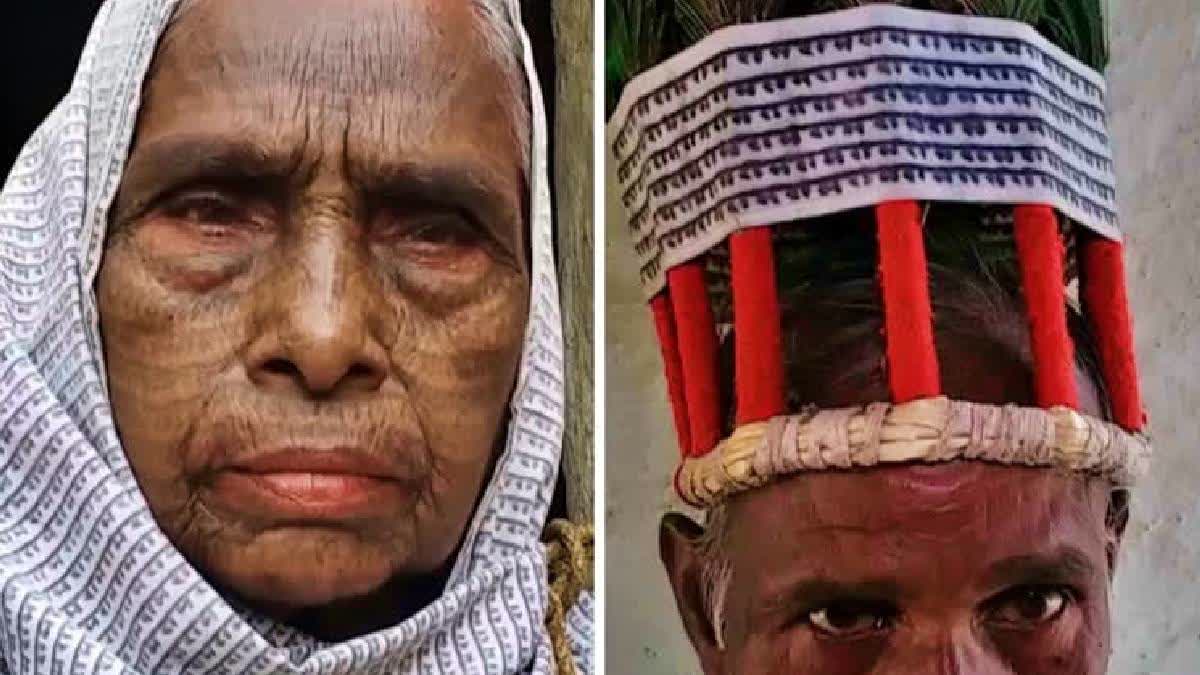Raipur: Mahanadi river known as Chhattisgarh's lifeline originates from Sihawa and as it flows down, it plays an important role in agriculture on both its banks. As the river reaches Balodabazar and Janjgir districts, one will get a glimpse of a culture that includes both spirituality and philosophy.
This culture belongs to the Ramnamis, who are devotees of Lord Ram. They believe that one who embraces the philosophy of Ramnami samaj, attains salvation. Ramnamis emerged as a peaceful form of resistance against the caste system. They have the name of Ram written on their faces and bodies to convey that Ram is omnipresent.
Gula Ram, a religious leader of the Ramnami community said, "In 1890, the upper caste people of the village prevented us from entering the temple. We were not allowed to worship. Then our Guru Parashuram got Lord Ram's name tattooed all over his body. Since then this tradition is carried forward.
A follower of Ramnami sect, Hiroudi Bai, a resident of Khaparadih village, adjacent to Nawagarh of Janjgir said, "I was not a Ramnami before marriage. It was only after seeing my in-laws that I got Ram's name written on my forehead. Later, I started participating in the hymns of Lord Ram," Hiroudi said.
Jyoti Devi, daughter-in-law of Hirodi Bai, when she saw Ram's name written across the body of a person, she was surprised. "After marriage, seeing everyone with Ram written on their bodies, I got adjusted. I have got Ram written on my forehead," she said.
'Odhni', which is a white cloth used for draping over the body is an integral part of the attires of Ramnamis. It is worn by both men and women. Some men make shirts, kurta or vests from this cloth. 'Ram-Ram' is written in black ink across this cloth
The Peacock crown, which is crafted with peacock features is considered an important symbol in Ramnami society. It is said that the peacock crown is a symbol of selflessness and abandonment of lust. Ramnamis wear this crown during mass bhajan.
'Ghunghrus' have a huge significance among Ramnamis and are tied on the feet while singing bhajans. Also, Ghunghrus are played to the rhythms of songs. These are made of bronze.
Ramnamis inscribed Ram's name on their bodies as they were prevented from worshipping inside the temple. They don't cremate the body after death as it is believed that Lord Ram is immortal and his name is written on the body.
When a child is 6-day old, Ram's name is inscribed on his forehead. Then when he turns five or gets married, Ram's name is inscribed on his body. Kunj Bihari, a resident of Chandlidih of Bilaigarh said, "There is no compulsion to inscribe Ram on the child's forehead. Be it a girl or boy, Ram bhajans are sung on the occasion. If the family wishes, they can voluntarily inscribe Ram's name on the forehead of the newborn."
However, the tradition of inscribing Ram's name on body or forehead is slowly decreasing as many of the youths travel to the cities for jobs. Also, the traditional method of writing the name is considered cumbersome. In order to generate awareness about the community, a fair is being organised in Pirda village.
Every year in the month of Magh the fair is organsied by the All India Ramnami Mahasabha. Rambhagat, an elder citizen of the society, said, "The fair is held on both sides of the Mahanadi. Bhajans are sung and Ramcharitmanas is recited on the occasion. The fair starts by writing the name of Ram on a white pillar and hoisting a white flag. People participating in the fair hold Ghunghrus as musical instruments. Many foreign tourists come to this fair."
Ram's name is tattooed manually by tying three wooden needles together and dipped in natural ink. The ink is made by collecting the soot by burning kerosene in a pot.
According to Kunjbihari, a student-year BSc student of Ravi Shankar Shukla Vishwavidyalaya, said those who want to join the army or police cannot have tattoos as it is not allowed in these services. "That's why the youth now avoid getting Ram's name written. Employment is a major reason due to which it is becoming difficult for the youth to follow social traditions," Kunjbihari said.
Thus, there are very few people left who have Ram's name written all over their bodies and all of them are senior citizens.
Read more



